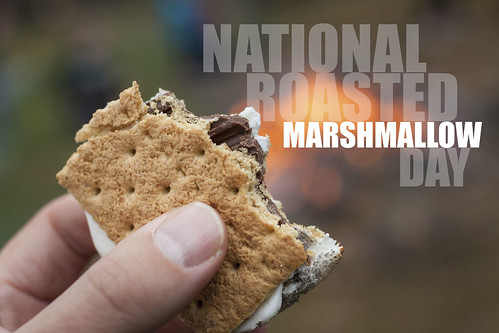
Some wonderful memories are born around a fire ring. But whether you are camping, “glamping” or sitting with friends and family in your backyard, waning evenings typically include one campfire staple: marshmallows.
So, on the eve of National Roasted Marshmallow Day (Aug. 30), we pay tribute to the sweet ingredient that makes any form of outdoor gathering, well, sweeter.
For some, the best use of marshmallows is as the gooey main ingredient of s’mores. Take a graham cracker, place a section of chocolate on it, and then carefully place a freshly roasted marshmallow on top of the candy bar. Top the marshmallow off with another graham cracker, carefully squeezing the campfire dessert sandwich together as the hot marshmallow melts the chocolate.
According to the National Confectioners Association, the history of s’mores is anyone’s guess. However, the s’more recipe is first found in the 1927 Girl Scouts Handbook and some people speculate the organization coined the name.
But as many national forests and grasslands visitors know, there is more than one way to roast a marshmallow.
First, let’s talk safety. Never start a campfire when there are fire restrictions in place. The restrictions are put in place for your safety and for the safety of others. If campfires are allowed, use an existing fire ring or pit. Be sure you are at least 15 feet from tent walls, trees or other flammable objects.
Most importantly, ensure you work closely with children and talk to them about fire danger, proper behavior and rules – then expect nothing less. No one knows how many children are burned in campfire incidents; however, you don’t need statistics to know precaution is a key to great camping experiences. Some experts advocate a 10-foot rule between young children and a campfire. For more information about campfire safety, let Smokey Bear guide you.

Now, let’s get to the marshmallow basics. Use a roasting stick of at least 30 inches in length. The degree a marshmallow is roasted runs the gamut, from the barely cooked, light caramel-colored outer layer to the flaming marshmallow that contains a gooey interior wrapped by a crispy, blackened shell. From there, most people graduate to s’mores and rarely move on.
But there are some innovative ways to roast the little white treats that can help cut down on the amount of sugar intake by the kids, thus making bedtime a little more doable.
Think fruit.
Even if the kids – including us older ones – insist on more traditional s’mores, there are some healthy tricks. Grill thin slices of pineapple and substitute chocolate for the sweet, warm fruit. You will still get a tasty treat but by substituting with fruit, it is healthier – as long as you watch the amount of marshmallows used. If you want to cut down even more on calories, try using slices of angel food cake instead of graham crackers.
You can also get a little inventive and move away from s’mores.
Grab a small bag of chocolate or peanut butter chips – or a combination of the two. Take a banana and slice one side open, exposing the fruit but leaving the peel intact. Slice the banana, add a few chocolate chips then top with tiny marshmallows. Or substitute the chips for blueberries from the local farmer’s market. Place the banana in aluminum foil and wrap tightly. Place the foil-wrapped fruit next to but not on the flames. Wait five to 10 minutes or enough time for the chips and marshmallows to melt. Open and enjoy with a spoon.
Another way to limit the amount of marshmallows used is to substitute them with marshmallow crème, a spreadable version of marshmallows that helps you more easily regulate portion. For healthier treats, use large strawberries, apple slices, banana chucks, pineapple or other fruit. Put a piece of fruit on a roasting stick, dip quickly in the crème and roast over indirect heat until a delicious golden brown. You’re still having campfire fun, but the focus is on a healthier evening snack.
There are many ways to make the end of your camping day a memorable time with snacks. How does your marshmallow roast?

